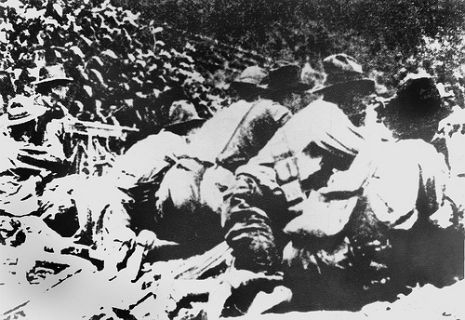
Saturday I received an email fundraising letter from former and hopefully future member of Congress, Alan Grayson of Florida. As readers of this blog know, I absolutely despise Republicans and about the best I can say about the Democrats is that I don’t hate them—I have almost no feelings about them whatsoever, although I always vote a straight Democratic ticket. But Alan Grayson is different and I like and admire him very much. He’s pretty much only slightly more of a Democrat than Vermont’s Bernie Sanders is (Sanders is an Independent/Socialist), and this is probably why I like him so much. Grayson’s about as far to the left as you can get and still be considered a Democrat.
In any case, in this weekend’s fundraising letter, reproduced here in full, Grayson tells the story of the “Battle of Blair Mountain,” the largest armed confrontation in the US since the Civil War. I was astonished to read about this. For one, I’d never even heard of it. Two, this happened in West Virginia, the state where I was born and raised. Every 8th grader—at least when I was in school, but I would imagine that this would still be the case—has to take a full year of “West Virginia History.” How was something like this basically erased from the history books, even on a local level like that?
What we are taught is “American history” is BUNK when things like the Battle of Blair Mountain are left out!
From Alan Grayson’s email:
This weekend marks the anniversary of the most brutal confrontation in the history of the American labor movement, the Battle of Blair Mountain. For one week during 1921, armed, striking coal miners battled scabs, a private militia, police officers and the US Army. 100 people died, 1,000 were arrested, and one million shots were fired. It was the largest armed rebellion in America since the Civil War.
This is how it happened. In the Twenties, West Virginia coal miners lived in “company towns.” The mining companies owned all the property. They literally ran union organizers out of town - or killed them.
In 1912, in a strike at Paint Creek, the mining company forced the striking miners and their families out of their homes, to live in tents. Then they sent armed goons into that tent city, and opened fire on men, women and children there with a machine gun.
By 1920, the United Mine Workers had organized the northern mines in West Virginia, but they were barred from the southern mines. When southern miners tried to join the union, they were fired and evicted. To show who was boss, one mining company tried to place machine guns on the roofs of buildings in town.
In Matewan, when the coal company goons came to town to take it upon themselves to enforce eviction notices, the mayor and the sheriff asked them to leave. The goons refused. Incredibly, the goons tried to arrest the sheriff, Sheriff Hatfield. Shots were fired, and the mayor and nine others were killed. But the company goons had to flee.
The government sided with the coal companies, and put Sheriff Hatfield on trial for murder. The jury acquitted him. Then they put the sheriff on trial for supposedly dynamiting a non-union mine. As the sheriff walked up the courthouse steps to stand trial again, unarmed, company goons shot him in cold blood. In front of his wife.
This led to open confrontations between miners on one hand, and police and company goons on the other. 13,000 armed miners assembled, and marched on the southern mines in Logan and Mingo Counties. They confronted a private militia of 2,000, hired by the coal companies.
President Harding was informed. He threatened to send in troops and even bombers to break the union. Many miners turned back, but then company goons started killing unarmed union men, and some armed miners pushed on. The militia attacked armed miners, and the coal companies hired airplanes to drop bombs on them. The US Army Air Force, as it was known then, observed the miners’ positions from overhead, and passed that information on to the coal companies.
The miners actually broke through the militia’s defensive perimeter, but after five days, the US Army intervened, and the miners stood down. By that time, 100 people were dead. Almost a thousand miners then were indicted for murder and treason. No one on the side of the coal companies was ever held accountable.
The Battle of Blair Mountain showed that the miners could not defeat the coal companies and the government in battle. But then something interesting happened: the miners defeated the coal companies and the government at the ballot box. In 1925, convicted miners were paroled. In 1932, Democrats won both the State House and the White House. In 1935, President Roosevelt signed the National Labor Relations Act. Eleven years after the Battle of Blair Mountain, the United Mine Workers organized the southern coal fields in West Virginia.
The Battle of Blair Mountain did not have a happy ending for Sheriff Hatfield, or his wife, or the 100 men, women and children who died, or the hundreds who were injured, or the thousands who lost their jobs. But it did have a happy ending for the right to organize, and the middle class, and America.
Now let me ask you one thing: had you ever heard of this landmark event in American history, the Battle of Blair Mountain, before you read this? And if not, then why not? Think about that.
Courage,
Alan Grayson
Makes you wonder what would Christian “historian” David Barton and the “Tea party patriot” set make of this? How would they even get their heads around it?
Donate to Alan Grayson’s political campaign here.

The Battle of Blair Mountain by Chris Hedges
The Battle of Blair Mountain, Round Two (Mother Jones)





